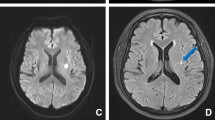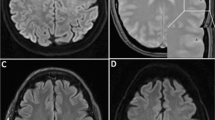Abstract
Diffusion-weighted imaging (DWI) is very sensitive to early brain infarcts. However, the late stages have been insufficiently studied. Infarcts in small vessel disease are often multiple and of different ages, and differentiation between new and old lesions might be difficult. We have therefore studied the change with time in DWI of small (< 3 ml) ischaemic lesions. We imaged 21 patients with an acute lacunar syndrome and a lesion visible on early DWI. They all had three MRI examinations 12–58 h (early), 7–16 and 54–144 days after the onset of stroke; 10 patients with high DWI signal on the third examination had a fourth examination 12–28 months after the stroke. MRI was performed at 1.5 T, using echo-planar DWI with 7 b-values from 0 to 1200 × 106 s/m2 and conventional T2-weighted imaging. After 7–16 days 18 of 21 lesions gave high signal on DWI, and 12/16 measurable lesions had a decreased apparent diffusion coefficient (ADC). After 54–144 days ten lesions still gave high DWI signal and two still had an ADC below normal. On the fourth examination there was no remaining high DWI signal and all ADC were higher than normal.
Similar content being viewed by others
Author information
Authors and Affiliations
Additional information
Received: 17 January 2000 Accepted: 21 April 2000
Rights and permissions
About this article
Cite this article
Geijer, B., Lindgren, A., Brockstedt, S. et al. Persistent high signal on diffusion-weighted MRI in the late stages of small cortical and lacunar ischaemic lesions. Neuroradiology 43, 115–122 (2001). https://doi.org/10.1007/s002340000489
Issue Date:
DOI: https://doi.org/10.1007/s002340000489




